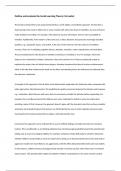Outline and evaluate the Social Learning Theory (16 marks)
The Social Learning Theory was proposed by Bandura, and it adopts a nomothetic approach. The key idea is
that learning is the result of either live or iconic models with whom the observer identifies. An array of factors
make imitation more likely. For example, if the observer has low self-esteem, they’re more susceptible to
imitation. Additionally, if the model is of the same sex, is older, attractive and possesses seemingly desirable
qualities, e.g., popularity, status, and wealth, in the eyes of the observer, then the chances of imitation
increase. There are 4 mediating cognitive factors: attention, retention, motor reproduction and motivation.
They are fundamental in the decision of whether a behaviour is imitated or not. For example, where the
observer isn’t motivated to imitate a behaviour, they won’t perform it or if they are physically unable to
replicate the action, they will refrain from doing so. Bandura introduced the idea of vicarious reinforcement,
which is the idea that reinforcement need not be direct and watching others be reinforced can indirectly alter
the observer’s behaviour.
A strength of this approach is that it offers a less deterministic explanation for behaviour when compared with
other approaches, like behaviourism. The mediational cognitive processes between the stimulus and response
e.g., motivation, afford humans with more time to consciously consider the stimulus before responding. For
example, Perry and Bussey found that children were more motivated to imitate a same sex model when
selecting a piece of fruit. However, the approach doesn’t agree with the humanist view that we have complete
autonomy and instead proposes that humans are still limited by the way in which cognitive processes work,
meaning that the Social Learning Theory adopts a soft deterministic view.
Conversely, this approach can be criticised for its use of artificial settings and tasks that have low mundane
realism. This is problematic as any findings obtained may risk being ungeneralisable beyond the experimental
setting, due to a lack of ecological validity. For example, in Bandura’s bobo doll study he aimed to determine
whether children would imitate a same sex model and in doing so, he discovered that those who observed an
aggressive model were more likely to act aggressively, with this effect being intensified with same-sex models.
In this instance, children merely acted aggressively towards a toy blow-up doll, where there were no harmful
repercussions. This provides little insight into whether children would behave in the same manner towards





